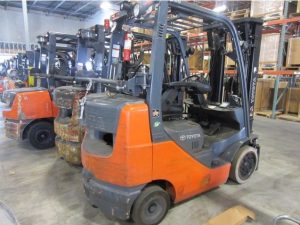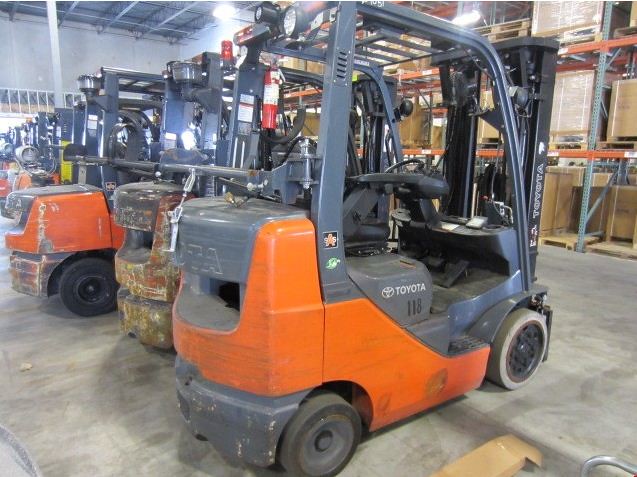Choosing Forklift Tires
Part III – How To Choose The Right Forklift Tires
In recent weeks we have been developing a series of blogs describing everything you ever want to know about forklift tires.
In Part I of the series we discussed the type of tires available for forklifts.
In Part II we covered what forklift tires are made of and how to read tire sizes.
In Part III we will be discussing how to choose the right forklift tires.
Choosing The Proper Tire
Selecting the proper forklift tires depends on the application in which the forklift is used, the forklift itself, and the work environment in which the tires are expected to perform.
There has been some confusion on matching tires to the forklift. For example, can pneumatic tires be used on a forklift that commonly uses cushion tires? The forklift’s wheels and frame are designed for a specific tire, usually pneumatic or cushion. It’s suggested that you consult with the local dealer from whom you purchase the tires as well as the forklift’s owner’s manual.
One thing is certain. You can switch from smooth cushion to traction cushion tires or pneumatic to solid pneumatic tires. However, only on rare occasions are you able to go from a cushion tire to a pneumatic tire or a pneumatic tire to a cushion version.
When you replace old, worn tires, be sure that both sides of the forklift have the same type of tire. The front and back can have different styles of tires. However, both front tires and both back tires should be the same type. To make this more obvious, you can’t use a smooth cushion tire on the right front and a traction cushion tire on the left front. Moreover, It’s okay to use two smooth cushion tires up front while using two traction cushion tires in the rear.
The Right Tire For The Application
As a fleet manager you have already learned that different applications require different types of forklifts. This is also true in the case of tires. Matching the right tires for the forklift based on application is not a difficult decision, but it is based on specific criteria.
For example, if the forklift will be used indoors on a floor that has no debris, then it is suggested you opt for cushion tires. In this environment, cushion tires last longer and offer better maneuverability and traction.
A forklift that is used outdoors and on rough terrain should use pneumatic or solid pneumatic tires. These tires offer better traction and stability on uneven, loose terrain.

Selecting tires depends on the application, the forklift, and the work environment.
(Courtesy: Maria Giorgio at flickr.com)
A forklift used in a warehouse to perform order picker tasks should use polyurethane tires. Polyurethane tires assists in improving on the expected battery life of an electric lift and offers better stability and traction.
A forklift used in a cold environment or an environment that includes floors that are consistently wet, it’s best to use polyurethane tires with micro grips or small, raised dots or tires that feature narrow or diagonal grooves for better traction and braking.
If the environment includes standing oil or consistent oil spills, you should consider polyurethane tires. These tires resist oil and breaks down less frequently than other styles of tires.
Forklifts being used in so-called sensitive applications including the handling of food, paper, or printing, would be best suited using non-marking tires. Standard tires include carbon black, which creates fine dust particles during use. These particles can cause cross-contamination problems.
Finally, some industries have certain standards involving the proper tire to use with a forklift. We will identify the proper tire for the industry below, but it is recommended that you check with the industry’s trade organization to determine which tire type is common for that industry.
• Agriculture = Solid Pneumatic
• Airport = Solid Pneumatic
• Beverage = Polyurethane
• Brick, block, and pipe = Solid Pneumatic
• Cold Storage = Polyurethane
• Concrete = Solid Pneumatic
• Distribution = Polyurethane or Cushion
• Factory = Cushion
• Food Processing = NM Cushion or Polyurethane
• Food Storage = NM Cushion or Polyurethane
• Forging and Casting = Solid Pneumatic
• Manufacturing = Cushion
• Warehousing = Cushion
• Intermodal and Port = Solid Pneumatic
• Lumber = Solid Pneumatic
• Mining = Solid Pneumatic
• Oil and Gas = Solid Pneumatic
• Paper =NM Cushion or Polyurethane
• Rail Yard =Solid Pneumatic
• Retail = Cushion
• Shipping Containers = Solid Pneumatic
• Steel and Metal = Solid Pneumatic
You should be aware that your industry’s standards are subject to change. So it’s advised that you consult with your forklift dealer to confirm the best choice for the situation.
(Source: conger.com)

